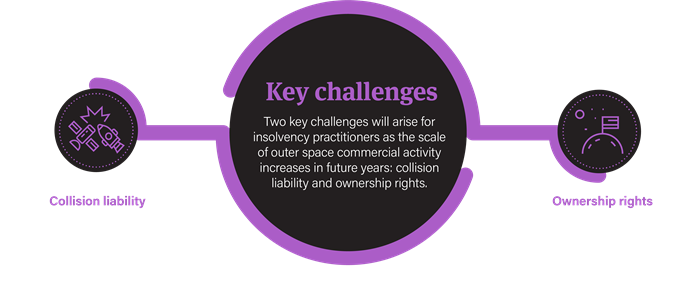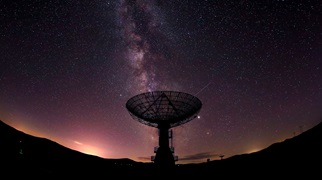Synopsis
Activities in outer space have increased significantly over the last few years. Governments across the globe have launched new space strategies and policies which identify investment in new space law projects, in both the public and private sector, as an important component of future economic growth. This ‘space economy’ is seen as a river of untapped potential.
While outer space activities were traditionally limited to state-based projects, a rapid technological and digital change over the last decade has seen a marked shift towards the commercialisation of space activities and the pursuit of those activities by private sector entities. Currently, the main commercial outer space activities relate to the use and operation of satellites – satellite television and communications services, as well as satellite imagery and surveillance, and satellite navigation. Indeed, the marked increase in satellite capability and activity from private enterprises globally has caused NASA to express concerns over the level of ‘space junk’ from operational and defunct satellites, as well as other space debris, and the safety risk to people and property in space and on Earth from this so-called ‘orbital graveyard’.1
However, there has also been progress in space mining. For example, Russia and the European Space Agency have established a program, PROSPECT,2 to test resource exploration potential in outer space and to work together to develop new technologies that may be used to extract those resources in future. The Chinese National Space Administration has also successfully collected moon samples under a series of Chang’e lunar missions designed to investigate the potential for a viable commercial resource exploitation program in outer space.
Space mining is expected to be the most significant future growth area in space activity, with the global demand for resources beyond those offered on our own planet Earth.
This immense appetite for increased public and private investment in new activities in outer space, backed by multi-jurisdictional partnerships as well as continuing enhancements in technological capability, will inevitably drive space-related restructuring in coming years as existing resources and technology entities transition their operations towards new investments and activities in outer space. This can be expected to result in continued innovation from businesses, and necessarily will also see an increase in start-up ventures and greater corporate risk-taking – which itself may spark further restructuring and insolvency activity.
The purpose of this article is to explore the intersection between outer space activities and restructuring and insolvency. We outline some of the challenges that may face insolvency practitioners in the context of an appointment to an entity conducting outer space activities, as well as the restructuring opportunities we are likely to see as the pace of global investment in outer space activities continues.
Key challenges

Collision liability
As identified above, the increase in satellite and other outer space based technology to support communications systems on Earth has resulted in more outer space ‘clutter’ in recent years. In turn, this has enhanced the risk of collisions in outer space.
A very difficult issue for an insolvency practitioner appointed to a satellite operator in this context is how to deal with collision claims against the debtor company or alternatively how to progress collision claims against other entities in discharging the practitioner’s investigatory and reporting obligations and overarching duty to act in the best interests of creditors.
There are currently five United Nations international space treaties which set out a framework to govern legal rights and obligations in outer space.3 Of those treaties, the Outer Space Treaty – which as at 1 January 2021 had been ratified by 110 countries, with another 23 having signed but not yet ratified the treaty – outlines the general principles for liability that may arise in a collision context, stating:
- Each state has international responsibility for the activities undertaken by governmental agencies and non-governmental entities from that state in outer space (Article VI).
- The activities of non-governmental entities in outer space require the authorisation and continuing supervision of each state (Article VI).
- Each state that ‘launches or procures the launching of an object’ into outer space and each state ‘from whose territory or facility an object is launched’ is internationally liable for damage to another state that is a party to the Outer Space Treaty or its natural or juridical persons (Article VII).
This is expanded on in the Liability Convention, which as at 1 January 2021 had been ratified by 98 countries, with another 19 having signed but not yet ratified the treaty. The Liability Convention crystallises the level of liability referred to in Article VII of the Outer Space Treaty. It divides that liability into two classes – that arising from damage which occurs on the surface of the Earth or to an aircraft on the one hand, and damage which is caused to another object in outer space on the other hand. The latter is relevant to the context of a satellite collision in outer space considered in this article. In that regard, according to Article III of the Liability Convention, the relevant state from which a satellite is launched is liable to another state from which another satellite is launched for any damage that is incurred, but only in the event of ‘fault’.
The standard of ‘fault’ is not delineated in the Liability Convention, and this creates considerable uncertainty in assessing the nature and scope of liability.
Moreover, the liability framework established by the Outer Space Treaty and the Liability Convention does not provide direct enforcement remedies to private entities, despite non-state activity in outer space overtaking the traditional government-focused space initiatives of previous decades.
To obtain a remedy under the international framework embodied in the United Nations treaties, it would be necessary for a private entity to request and obtain the agreement of its national government for that government to prosecute a claim on the entity’s behalf through diplomatic channels.4 Even if acceptance was secured, there would be significant delay in securing an outcome via those diplomatic channels, or the alternate ‘Claims Commission’ framework established under the Liability Convention.5
Given the uncertainty in relation to the scope of liability for an outer space collision, and the means for private entities to enforce any potential claim, international arbitration has been seen as a viable solution for disputing parties. There has been a focus in the industry on designing appropriate arbitral rules that could be adopted by disputing parties to guide the arbitral process specifically in a space law context, such as the Permanent Court of Arbitration’s Optional Rules for Arbitration of Disputes Relating to Outer Space Activities. There is also the potential for a standalone international arbitral centre to be established in relation to outer space collision liability and other disputes, as distinct from the conduct of an arbitration through existing general commercial arbitral institutions such as the International Chamber of Commerce, the International Centre for Dispute Resolution and the London Court of International Arbitration.
In an insolvency context, a practitioner would need to be aware of these limitations – both procedural as well as in assessing and quantifying substantive liability. Significant costs, delays and uncertainty could, in turn, undermine the achievement of efficiency and maximum returns for creditors during the insolvency process, and also inhibit a potential restructure which relies on speed, simplicity and the preservation of an entity’s scarce capital.
That said, there is a possible role for the UNCITRAL Model Law on Cross-Border Insolvency, at least in terms of achieving greater procedural certainty and multi-state cooperation where an outer space collision involves a corporate debtor and one or more third parties in other jurisdictions.
Specifically, Articles 25 and 26 of the Model Law require courts to cooperate ‘to the maximum extent possible’ with their foreign counterparts in connection with the conduct of a recognised insolvency proceeding and to investigate and pursue appropriate forms of communication.
Possible forms of cooperation and communication are identified in Article 27, with the final choice of those mechanisms left to the discretion of the relevant courts in each jurisdiction. Notably, Article 27(a) states that a possible form of cooperation is ‘the appointment of a person or body to act at the discretion of the court’. This is apt to include an arbitrator or mediator.
Thus, where an insolvency practitioner appointed over a satellite operator seeks recognition of the insolvency proceeding in a jurisdiction that has adopted the Model Law, and the practitioner is also faced with an outer space collision claim (whether the satellite operator is the plaintiff or the defendant), there would be an avenue for the practitioner to apply to the relevant courts in that jurisdiction and seek an order for cooperation via the appointment of a mediator or arbitrator to assist in the resolution of the dispute. The parties would then be invited to make submissions on the manner in which the arbitration or mediation would proceed.
Nevertheless, while helpful from a procedural certainty and efficiency perspective, the lack of consistency in international approaches to the determination of substantive liability for a satellite collision in outer space remains. This is a matter that an insolvency practitioner would need to assess in determining the viability of bringing a claim as the plaintiff on behalf of the satellite operator undergoing the relevant insolvency process, and in determining the viability of a restructuring designed to rescue the operator as a going concern when the operator is faced with a potential collision claim as the defendant.
Ownership rights
While the Outer Space Treaty is clear that objects launched into outer space, such as satellites, remain under the ownership of the launching state (or private entities within the launching state, as the case may be), the existing international framework is not clear about the ownership of assets taken from outer space.
This is another challenging area that insolvency practitioners will need to be mindful of as the scope of mining operations in outer space continues to be investigated and expanded both publicly and privately. In the event that a practitioner was appointed over an entity that engaged in those operations, it would become necessary – as an incident of the practitioner’s duty to collect and distribute assets and resolve creditor claims – to determine the entity’s ownership of any resources appropriated from outer space, and any competing claims to those resources that may be asserted by the entity’s creditors.
The Outer Space Treaty only touches on ownership rights in relation to resources acquired in outer space peripherally, with Article II stating:
‘Outer space, including the moon and other celestial bodies, is not subject to national appropriation by claim of sovereignty, by means of use or occupation, or by any other means.’
Yet there is no explicit denial of ownership rights by private entities – only an inability to acquire objects in outer space by means of ‘national appropriation’, and only by states. It is also arguable that mining resources acquired from outer space are not ‘outer space’ in their own right.
The ownership of resources acquired from outer space is more explicitly dealt with in the Moon Agreement. In relation to resources on the moon (but not other celestial bodies), Article XI states not only that the moon is not subject to national appropriation by any claim of sovereignty (the language adopted in the Outer Space Treaty), but also that ‘the moon and its natural resources are the common heritage of mankind.’ Further, Article XI provides:
‘Neither the surface nor the subsurface of the moon, nor any part thereof or natural resources in place, shall become the property of any state, nor any entities or natural persons.’
Article XI also provides a framework for signatory states to ‘establish an international regime … to govern the exploitation of the natural resources of the moon’, which is to include a process for the ‘equitable sharing’ of benefits from the resources.
However, apart from the fact that the Moon Agreement is limited to resources acquired from the moon (and does not extend to resources from other celestial bodies), it is notable that the instrument had, as at 1 January 2021, only been ratified by 18 countries and signed without ratification by four others. The ‘common ownership’ of resources mined from outer space is accordingly far from having the status of an international norm.
Already, some jurisdictions have enacted domestic provisions which are intended to provide a framework for private ownership rights. For example, the United States, which has not ratified or signed the Moon Agreement, enacted the Commercial Space Launch Competitiveness Act 2015 (US), which recognises the right of private United States companies to engage in the exploration and extraction of space resources from celestial bodies. An Executive Order issued by the former Trump Administration in April 20206 reiterates this position, with an express disavowal of the Moon Agreement ownership framework and the notion that outer space, and resources in it, are a ‘global commons’. The Executive Order also states the United States’ position that the existing international framework has, unsatisfactorily, discouraged commercial exploration activities to recover and use outer space resources, and reiterates:
‘Americans should have the right to engage in commercial exploration, recovery and use of resources in outer space, consistent with applicable law.’
The United States position is that this framework is not inconsistent with its obligations under the Outer Space Treaty because it is not seeking to ‘assert sovereignty or sovereign exclusive rights or jurisdiction over, or the ownership of, any celestial body’, as distinct from permitting its citizens to engage in activities and acquire ownership of resources in a private capacity.
The extent of private ownership rights in outer space resources will be a matter that will come to a head in the future, as more countries test the boundaries of international law in pursuit of domestic policies that, as noted above, clearly position space exploration and the recovery of space mining resources as an important component of economic growth and expansion beyond the finite resources of planet Earth. As technological advancements continue, the prospect of space mining will become even more tangible and this will give greater impetus for this tension to manifest.
In this context, there will be a significant area of complexity for insolvency practitioners whose appointments cover space mining assets in future, and there will likely be an increase in complex cross-border disputes, and an inevitable interplay between competing incidents of insolvency law, private domestic law and international law.
Restructuring opportunities
The substantial investments being made by governments globally in relation to space law commercial capability is also likely to support the reallocation of capital by private entities seeking to take advantage of the new opportunities on offer. This will especially be the case for resources entities seeking to explore new mining potential in outer space to mitigate the impact of a transition towards a lower carbon economy on planet Earth, as well as for technology companies seeking to develop new communications and digital enhancements supported by satellites and other infrastructure launched and embedded in outer space. For these entities, reallocation of capital and other resources will be necessary to support new outer space commercial activities.
In that sense, there is a clear synergy between space law restructuring opportunities and two of the most defining global trends we are now seeing: ESG (and the necessary transition towards net zero emissions by 2050) and rapid digitisation.
The investment of new capital in still-emerging areas in outer space technology and mining opportunities will of course be high risk, and this will likely see the proliferation of new start-up ventures, and a ‘boom or bust’ cycle in which some entities will inevitably become insolvent and will be prime candidates for restructuring.
A recent example is the successful restructuring of OneWeb, a global broadband satellite constellation company which began as a start-up but came to operate over 650 low Earth orbit satellites. OneWeb emerged from a Chapter 11 reorganisation in the United States in November 2020 following the Bankruptcy Court’s approval of a $1 billion sale to Bharti Global and the United Kingdom Government, which each secured a 42.2% stake in OneWeb. In explaining the investment, United Kingdom Business Secretary Alok Sharma said that the OneWeb stake reflected the Government’s ‘commitment to the UK space sector in the long-term and our ambition to put Britain at the cutting edge of the latest advances in space technology’.
This kind of immense public-private investment potential, across multiple jurisdictions, will be a clear driver not only of further commercial space law companies and activities in future years, but also the underlying restructuring opportunities that are a necessary adjunct to the level of activity we will see.

























